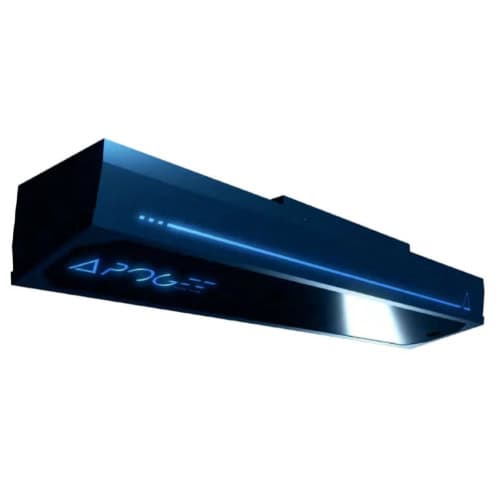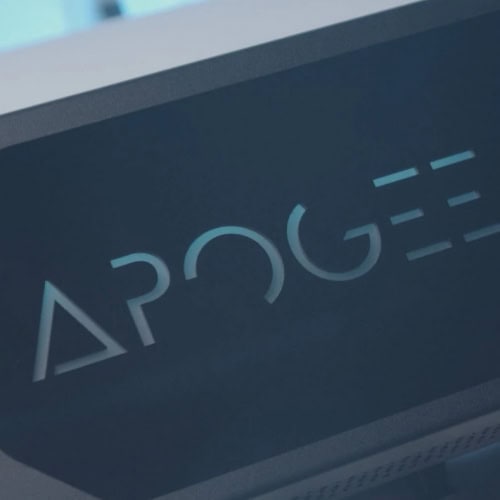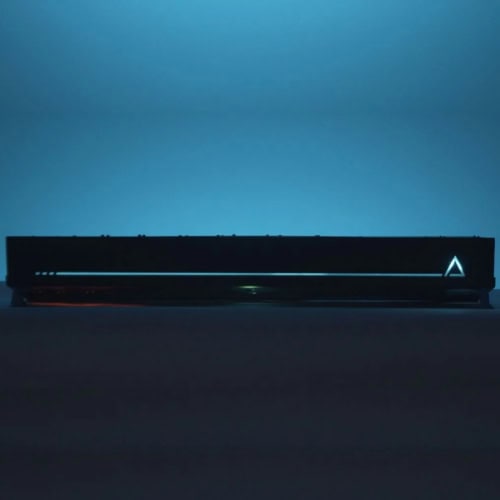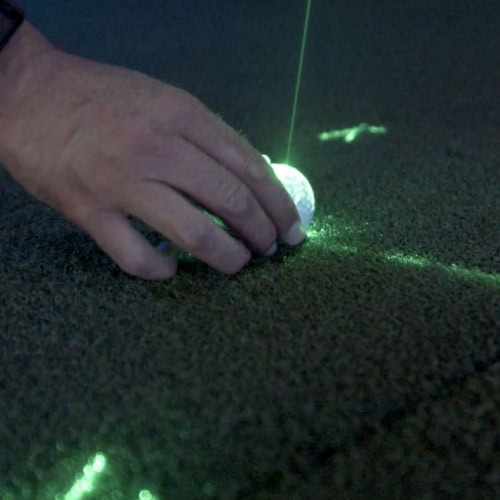TruGolf’s Apogee launch monitor has made a bold entrance into the high-end simulator scene, and for good reason. It’s not just another shiny box that spits out spin rates; it’s a ceiling-mounted machine that reimagines what a simulator setup can look like.
Why should you care? Because if you’ve been tripping over floor units, dealing with frustrating calibration or just tired of guessing whether your 7-iron really carried 168 yards, the Apogee promises answers with precision, and without the clutter.
This guide will explore how the Apogee works, what it gets right (and wrong) and who it’s actually made for. If you’re a home user, coach or studio owner, we’ll help you decide if this is the launch monitor that finally earns a permanent spot above your hitting mat.
What Is the TruGolf Apogee and Who Is It For?
First released in 2023, the Apogee was TruGolf’s answer to the growing demand for permanent installs. Think high-performance setups without wires across your floor or gear that needs constant adjustment. Instead, it sits quietly above you, watching every shot with military-grade tracking.
This monitor fits like a glove in home golf studios, especially those tight on space. If you’ve got a low ceiling, you’re out of luck. But if you’ve got at least 9 feet to work with and want a clean, professional look, it’s a no-brainer. It’s also a favorite for teaching pros who don’t want to reposition hardware between students.
Commercial facilities are also leaning in, as Apogee offers a reliable, low-touch setup that handles heavy traffic. No moving parts, fewer support headaches. And with voice commands and E6 Connect baked in, it’s built for smoother customer sessions.
Now, let’s talk models. TruGolf offers a range of options, but Apogee is their flagship ceiling unit. It’s not an upgrade from the Vista or Signature—it’s a different beast. While their floor-based systems target portable setups, Apogee was designed to stay in place and do work.
Key Features of the TruGolf Apogee

The Apogee is packed with features that go beyond simple ball tracking. Each component is engineered to make your indoor practice sessions smoother, smarter and more immersive.
Ceiling-Mounted Infrared Tracking System
Most launch monitors sit on the ground. Apogee takes a smarter route. It mounts on the ceiling—completely out of your swing path, giving you room to breathe and swing freely. No clutter. No risk of knocking anything over with your follow-through.
Advantages for Small Space Setups
If your space is tight, Apogee gives you breathing room. With the tech overhead, you don’t have to leave a buffer around your hitting zone. It’s perfect for garages, spare rooms and basement setups where floor units are a constant obstacle. Ceiling mounting also means fewer worries about errant swings damaging your gear.
If you’re evaluating different ceiling-mounted options, it’s worth looking at how Apogee compares to other advanced systems. A detailed breakdown of the Trugolf Apogee vs. Protee VX highlights the differences in tracking accuracy, features, and space requirements.
Setup Flexibility and Wall Clearance Benefits
Forget the usual “stand here only” problem. Apogee tracks across a wide hitting area (8”x10”), regardless of stance or hand dominance. You don’t need special markings or reflective gear. And with no hardware in the way, you can bring your screen closer to the wall, maximizing usable space without compromising the shot window.
Instant Feedback With No Lag

The Apogee processes your swing in real time using dual high-speed infrared cameras. The transition from strike to ball flight is smooth and immediate. That timing is crucial—it helps you stay focused, make adjustments faster and practice with purpose.
The unit also works natively with E6 Connect, streaming your shot results into high-resolution visual environments. Whether you’re grinding on the virtual range or playing full 18-hole courses, the visual feedback is instant and realistic. Every shot feels connected to what you just did, not what happened a second ago.
Voice-Activated Controls
Voice commands let you control the simulator without stopping to click or tap. It’s a small feature that makes a big difference in solo sessions or coaching environments.
Just say the word. Whether you’re switching clubs, replaying a shot or restarting a hole, the system responds without delay. This keeps you in flow, especially when you’re deep into a range session or grinding through a practice routine.
You can train alone without breaking rhythm. Custom commands let you tailor the experience: change ball position, skip animations or reset your shot. Voice control adds convenience, reduces distractions and keeps your focus on your swing.
Club and Ball Data Captured
Apogee’s data capture is comprehensive. It sees the fine details of every swing and delivers a robust set of metrics without relying on stickers or extra accessories.
You get a full range of metrics, including ball speed, launch angle, backspin, sidespin, carry distance, clubhead speed, club path, attack angle, and face angle.
Infrared tech means fewer limitations. Apogee doesn’t depend on ambient light (like purely photometric systems) or large tracking zones (required by radar). It captures club and ball data instantly, minimizing lag and missed reads. Tests show it competes head-to-head with elite models like GCQuad and Uneekor EYE XO.
Setup and Installation Experience

Installing a launch monitor shouldn’t feel like wiring a spaceship. Apogee keeps things streamlined, but it’s not plug-and-play in the traditional sense. Here’s what you need to know before grabbing a ladder and your drill.
Mounting and Calibration Process
The Apogee is built for ceiling mounting, sitting 21 to 25 inches in front of the tee area and 9 to 10 feet above the floor. The mounting hardware is included, along with a laser level and calibration tools to ensure proper alignment. Once mounted, the Apogee uses its onboard diagnostics and automated calibration system through the Apogee Control Center (ACC), which makes fine-tuning fast and repeatable.
Proper lighting matters. Though the system performs well in most indoor environments, major lighting changes may trigger the need for recalibration. Most users report setup takes about 30–45 minutes from unboxing to first swings.
Room Size and Ceiling Height Requirements
To function at its best, Apogee requires at least 9 feet of ceiling height, but 10 is better for comfort. The optimal hitting area is clearly projected on the mat via a laser-defined 8”x10” tee box. You’ll want a space that’s around 10–12 feet wide and 16–18 feet deep to accommodate swing room, ball flight and screen distance.
This setup supports both right- and left-handed players with no repositioning needed, which makes it ideal for multi-user environments or commercial simulators.
Cable Management and Hardware Overview
The package includes the Apogee unit, mounting bracket, CAT6 data cable, power supply, laser level, and an E6 CONNECT license. It connects to a PC using Ethernet (no Wi-Fi recommended here) and requires a direct power source.
Inside, the unit houses TruGolf’s dual-camera stereoscopic imaging system paired with the INSTANT IMPACT analysis engine. This combination tracks both ball and club data without requiring stickers or marked balls. The cameras work in tandem with infrared tracking to deliver precise measurements at ultra-fast speeds, typically rendering shot data in less than a third of a second.
E6 Connect Software Integration

Out of the box, you get the E6 Connect Practice software license. This includes a driving range, skill challenges, shot replay, and performance analytics. For those wanting more, you can upgrade to the full E6 Connect subscription, unlocking a library of famous courses, mini-games and online tournaments.
There’s no need for third-party software. Apogee and E6 Connect are built to run as a unified system, with automatic syncing between hardware and in-game visuals. The interface is clean, fast and clearly designed with the indoor golfer in mind.
Course Selection and Gameplay Realism
E6’s graphics are sharp, but it’s the ball physics that steal the show. Ball speed, spin and launch translate into realistic trajectories that behave as they would outdoors. When you land a draw on a virtual fairway, it feels earned.
Courses include a mix of real-world championship layouts and fantasy tracks. You can play 9-hole sprints or full 18s, solo or with friends. The realism can be brutally honest: thin a wedge, and you’ll see it flutter short of the green just like in real life.
Shot shaping, wind conditions and surface interaction are meant to mimic real-world responses. You won’t just be swinging in front of a screen. You’ll be solving problems like you would on a Sunday morning at your local course.
Software Updates and Subscription Model
E6 Connect is a one-time purchase with Apogee for the base version, which sets it apart from systems that tie you into monthly fees. Updates to the software are included, and TruGolf continues to develop new features under the upcoming E6 APEX platform.
If you upgrade, you can access 4K visuals, peer-to-peer multiplayer and live stat tracking. The full version includes over 90 courses and several skill-building tools.
Performance Testing: Accuracy and Consistency

Testing took place in a controlled indoor setting with a 10-foot ceiling and 16 feet of depth. Lighting was moderate and consistent. Apogee was mounted 22 inches ahead of the hitting zone, per spec, and connected via CAT6 to a PC running E6 Connect.
We hit over 1,000 shots using a mix of premium golf balls across a range of clubs: wedges, mid-irons, hybrids, and driver. Shots were taken by both scratch players and high handicappers to measure how the Apogee responded to varied impact patterns.
Spin rates stayed stable, even on mis-hits. Club path, face angle and carry yardage tracked closely with expected outcomes. The laser-defined tee box helped reduce misreads, especially with high-lofted wedges. Only rare edge-case shots (thin toe strikes or heavy chunks) caused minor inconsistencies.
If you want a deeper breakdown of measurement reliability, the TruGolf accuracy guide explores how these systems perform under different playing conditions and what level of precision you can expect in real use.
Shot Dispersion Consistency Over 1,000+ Shots
Dispersion patterns held tight. Data didn’t bounce around or vary wildly from session to session. For players working on distance control and face alignment, this matters. The Apogee gave actionable numbers you could trust from one day to the next.
Launch angles matched expected trajectories across club types. Wedges launched high with steep descent angles. Mid-irons had tight grouping, and driver performance was within 2–3 yards of expected averages based on real-world data from outdoor rounds.
When ball contact was clean, the unit delivered feedback within 0.3 seconds. It was enough to keep tempo sharp and drills focused. Even with back-to-back swings, the system kept pace without hiccups or recalibration.
Pros and Cons
The Apogee launch monitor isn’t perfect, but depending on how you play and what you value, its trade-offs might land in your favor.
What the Apogee Gets Right
- Clean Overhead Design – Nothing clutters your hitting area. No stands. No trip hazards. Just a ceiling-mounted unit that stays out of the way and out of harm’s reach.
- No Stickers, No Setup Hassles – You can use any club—no markers, dots or prep. That means faster sessions and fewer interruptions.
- Fast, Consistent Feedback – The data shows up instantly without lag or buffering; just clean transitions from swing to screen.
- Comprehensive Data Without Subscription Fees – You get full club and ball metrics with the base unit. No need to tack on extra fees just to access features you thought were included.
- Voice Controls and Smart UI – When the voice control behaves, it’s a slick way to change settings without leaving your stance. The Apogee Control Center also makes diagnostics and updates simple.
- E6 Integration – Out of the box, it’s fully paired with E6 Connect. You don’t have to worry about third-party compatibility issues or broken links between hardware and software.
Where the Apogee Misses
- High Upfront Cost – It’s not a budget choice. At over $9K, it’s priced for serious players, coaches or facilities.
- Ceiling-Mount Limitations – The Apogee needs at least 9 feet, ideally more.
Price and Value for Money

While the official retail price is $11,495, you can often find sales or bundles that sweeten the deal. Discounts of up to $2,000 are frequently available through trusted partners. Keep an eye out for packages that include hitting mats, enclosures or upgraded software licenses.
Financing options also exist through most major golf sim retailers, letting you spread out the cost without compromising your setup.
Bundles and Subscription Costs
The Apogee comes with a base version of E6 Connect, allowing for practice sessions, shot replays and training tools. If you want access to full-course play, multiplayer modes and expanded features, a one-time $1,000 upgrade unlocks everything.
There are no monthly fees required to access your core data. You get ball speed, launch angle, spin rates, club path, and face angle—all without ongoing subscriptions or hidden paywalls.
Where to Buy?
Choosing the right retailer can make or break your purchase experience. Here are four top places to buy the Apogee with confidence:
FAQs
The following are some frequently asked questions about the Apogee launch monitor, answered by our team to help you learn as much as possible about the device.
Is the TruGolf Apogee accurate for club data analysis?
Yes, it holds its own against the best. Apogee uses a dual-camera setup with high-speed imaging and TruGolf’s INSTANT IMPACT algorithm. You get data on clubhead speed, face angle, path and attack angle without needing stickers. It’s accurate enough for coaches and repeatable enough for consistent training. Mis-hits may occasionally throw it off, but solid contact gets solid numbers.
Can the Apogee be used outdoors?
No. Apogee is strictly an indoor unit. The camera-based tracking system depends on controlled lighting and a ceiling mount. Sunlight and inconsistent environments throw off the sensors.
How does voice control improve simulator workflow?
Voice control can speed things up, especially during solo practice. You can reset shots, change clubs or replay swings without touching a keyboard. That said, the feature can be hit-or-miss depending on noise levels and accents.
Can the Apogee be used with left- and right-handed players?
Yes. Apogee tracks both without repositioning the unit. You don’t need to tweak settings or re-calibrate between players. Just tee up and swing. This is a big plus for families, group practice or coaching sessions with mixed players.
Final Verdict: Is the TruGolf Apogee Worth It?
The Apogee isn’t trying to reinvent launch monitors—it just does the core things right. Fast reads, clean data, no stickers, and no gear to shuffle around. It thrives in permanent indoor setups, where space is optimized and distractions are minimal. If your priority is dependable swing feedback without babysitting the tech, the Apogee checks that box every time.
The price is steep, but so is the time you save on setup and troubleshooting. It stays out of your way and quietly delivers, shot after shot. For those who are committed to practice and want their gear to keep pace, the Apogee earns its ceiling spot.
If you’re also considering alternatives, our detailed comparison of the Trugolf Apogee vs. Uneekor Eye Xo2 breaks down how these two premium systems differ in accuracy, setup, and overall performance.
Thanks for reading!





